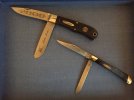- Joined
- Jan 3, 2013
- Messages
- 5,713
Having skinned a few animals, I'll take a shot at answering.
When it comes to making the initial cuts to open the pelt, the spey's lack of a tip is a handicap. You can do it, but it is slower than using a clip blade. From that point, a spey blade shines at skinning. The goal is to separate the pelt from the carcass without damaging the skin. Due to the shape of the tip, a spey blade can be used more aggressively for this than can a pointed blade. You work the hide loose, then use the knife to sever the connecting tissue. The rounded tip keeps you from poking holes in the hide.
Folks who engage in competitive skinning (of muskrats, for instance) tend to use a very sharp paring knife. In practice, this isn't much different from the old trappers' muskrat pattern, with a clip blade on each end.
When skinning larger game (deer for example), a spey blade works the same way. When using a trapper to dress and skin a deer, I usually just make an initial cut with the clip blade, then do the rest with the spey blade. It reduces the chance of penetrating the stomach and intestines, and yields a clean hide and carcass, but mostly, it is what I'm used to.
I always liked the idea of wharncliffe trappers, but I'd prefer a wharncliffe/spey combination. To me, a clip/wharncliff combination doesn't seem to offer any usable advantages.
Excellent post and I have to agree on the clip/wharncliff combo. I really don't see much use in the wharncliff when it comes to skinning.



